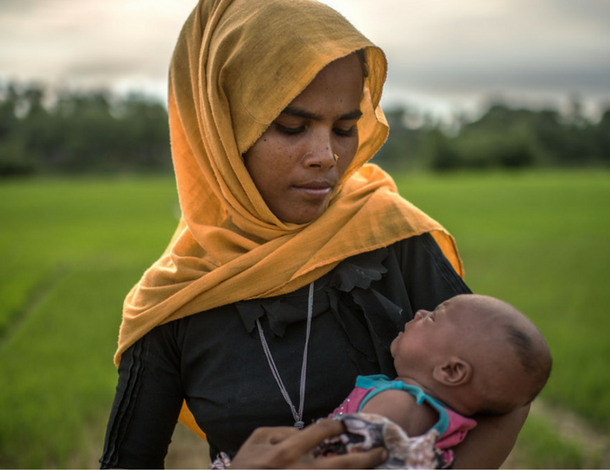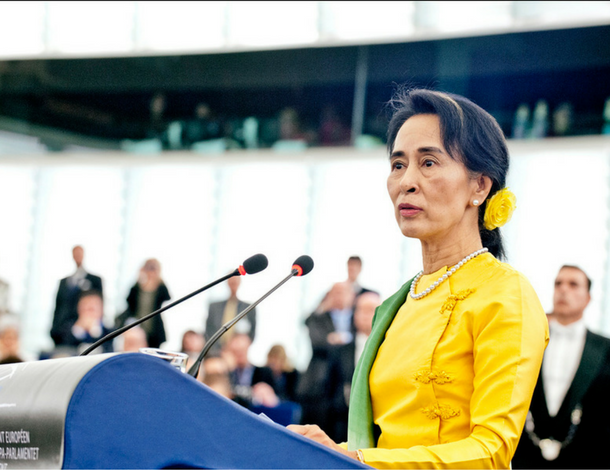As the world watches, “a text book example of ethnic cleansing” and the world’s fastest-growing refugee crisis is underway in Myanmar (formerly known as Burma). Since August, the army has been engaged in an operation that has involved mass killings, the razing of entire villages, and huge forced displacement - ostensibly in response to attacks on police posts by a group of fighters known as the Arakan Rohingya Salvation Army (ARSA).
AWID spoke to women activists in Myanmar to shed light on the different factors driving this unprecedented human rights and humanitarian crisis and its many gender dimensions.
What is happening?
In only seven weeks over 582,000 people from the Rohingya ethnic community have been pushed out of Myanmar’s Rakhine State to neighboring Bangladesh.
“This is very serious, possibly the worst outbreak of violence we have experienced in Rakhine so far,” explains Wai Wai Nu, a young Rohingya woman and former political prisoner based in Yangon who works to promote women’s rights and peace. “Almost half of the entire Rohingya population is now gone.”
The latest information gathered by OHCHR indicates that the brutal attacks carried out by the Myanmar military - often with support from groups of armed ethnic Rakhine men - have been “well-organised, coordinated and systematic.” The report points to the destruction of houses, crops, livestock, and even trees, as an indication that security forces want to make it impossible for the Rohingya to ever return to their normal lives and livelihoods.
Since the start of the military campaign, international aid organizations, including the United Nations, have been blocked from entering northern Rakhine, the epicentre of the strife.
“[Some people remained] stuck along the riverbank in Maungdaw district because they [didn’t] have the money to pay for the boat ride to escape,” says Wai Wai. “They are getting no help, no food, no shelter.”
Organizations working with Rohingya refugees in Bangladesh are completely overwhelmed by the speed and scale of the humanitarian crisis. They have received hundreds of chilling reports of sexual and gender-based violence against women and girls fleeing the fighting. These violations have triggered an outcry by the UN warning they “may amount to crimes against humanity”.
With 53 percent of refugees female, and 58 percent minors according to Oxfam, the high risk of further exploitation, trafficking, and abuse has put aid and human rights workers on the ground on high alert.
What’s behind the violence?
Effectively denied citizenship by the 1982 Citizenship Law, the Rohingya people have endured a complex history of discrimination under successive Myanmar governments. Of those who have not already fled earlier episodes of violence, the vast majority live in dire conditions in Rakhine State, where the poverty rate is 78%. Some 120,000 live in internment camps within Rakhine, relying completely on international aid.
"Rohingya women who experience violence receive little to no sympathy from the public due to their skin color, beliefs and, most important, their citizenship status as 'the others’”, says Stella Naw, a Myanmar independent writer and analyst, advocating for political and gender equality.

In addition to the unprecedented levels of insecurity and lack of protection Rohingya women face constantly, there are a number of unique and restricting policies that target them by stipulating for example the number of children they can have and their ability to marry.
These policies are part of a package known as the “Race and Religion” laws, which also place extensive restrictions on Buddhist women wishing to marry non-Buddhist men, and forces non-Buddhist men to convert to Buddhism before marrying Buddhist women.
According to Stella the laws “aim to protect the "pure blood" of the Burmese Buddhist population, the majority. They indicate a perception that this majority is somehow culturally and ethnically superior to others, and seeks to limit or even terminate those who are different."
The rise of Buddhist ethno-nationalism
The passing of these laws in 2015 was a major win for fundamentalist and ethno-nationalist Buddhist movements, which, while far from new, have gained heightened prominence alongside Burma’s transition towards democracy.
Buddhist nationalist groups - the most notable being Ma Ba Tha (Association for the Protection of Race and Religion) and the connected 969 Movement - are centred on ethnic purism and xenophobia, presenting “Burmese” as synonymous with Buddhist, and spreading the idea that the nation is under threat from infiltration by Muslims.
They capitalize on the false yet widely-accepted claim that the Muslim Rohingya are “illegal immigrants” from Bangladesh, and wrap their ideology in religious language - the 969 movement has even spread the idea that the Rohingya are reincarnated from snakes and insects.
Like far-right and fundamentalist movements the world over, notions of gender are central to the Buddhist nationalism at play in Myanmar. Nationalist groups depict Muslim men as a rapacious menace to Buddhist women, and interfaith marriage as a demographic threat to the nation.
Extractivism and state economic interests
Another factor behind the violence lies in the economic interests of the state. Parts of Rakhine State, along with other “ethnic borderlands” of Myanmar, have long been of interest to the state and foreign trade because of their natural resources.
Through the Junta period, the regime reaped the profit of projects in various conflict-affected border regions extracting coal, oil, gas, gemstones, and precious metals. These extractive projects brought militarization and human rights abuses with them, as the state brought in its security forces to grab land and secure the projects.
Some analysts are suggesting that economic interests are fuelling the current violence in Rakhine. Some point to possible connections between the violence and a new multibillion-dollar China-Burma oil and gas pipeline taking gas from fields off the coast of Rakhine, through Burma into Southwest China, with the security of the project overseen by the Burmese government.
“The army’s plan is to take the land from the Rohingya and, as they have done before, move those that stay behind to the camps, where they will continue to be deprived of their rights and be further segregated,” Wai Wai told us.
In fact, the process looks to already be underway. Some weeks into the violence, the government announced that it would “redevelop” Maungtaw region according to the Natural Disaster Management Law, which instructs that “burnt lands” be turned over to the state for management. Other reports suggest that the state intends to establish a Special Economic Zone in Maungdaw - an area where business and trade laws differ from rest of the country.
The perfect storm
While some analysts are emphasizing either economic agendas or Buddhist nationalism as the main force behind the violence, it seems that one factor is entwined with the other.
The work of feminists challenging fundamentalisms, including AWID’s research over the years, has found clear links between neoliberal economic models and the increased power of regressive identity-based movements. It has also shown that while religion is never the only factor at play, fundamentalisms work to naturalize, even radicalize, inequality and discrimination by giving “divine” backing to existing power imbalances.
Economic factors may well be behind the state’s push to eliminate the Rohingya from northern Rakhine, but it is the societal scapegoating of the Rohingya - itself exacerbated by the neoliberalisation of Myanmar’s economy - that has enabled the military to carry out full-scale ethnic cleansing with next to no domestic outcry.
Insufficient Response
The country’s de facto head of state, Aung San Suu Kyi, once a global icon of human rights and democracy, has repeatedly failed to criticize the army’s actions in Rakhine. In fact, deep rooted hostility towards the Muslim Rohingya population seems to now be the one thing binding together Aung San Suu Kyi’s party, the army that once opposed her, and the majority of people in Myanmar.
Stella says the widespread support the army has secured by portraying the Rohingya people as the “other” and as “terrorists” has shocked many seasoned analysts like her.
“For much of our society, the suffering and plight of the Rohingya community has become secondary to their legal status. Their right or not to call Burma their home is at the heart of the discussion, instead of trying to urgently find ways to stop the atrocities being committed against them.”

Women’s rights organizations in the country have remained mostly silent during this crisis. This is surprising given that only a few years back hundreds of women’s organisations and activists united to push back against the Race and Religion laws. A 2014 joint statement flagged how the bills would further restrict women’s freedoms, and warned that the laws were designed to target the Muslim community.
This time around things look very different. The army has managed to rally unprecedented support, backed up by intense propaganda efforts that focus on the threat of Islamist terror. “Most of the groups have preferred to remain silent or have sided with the Rakhine ethnic community,” notes Tin Tin Nyu, Chairperson of the Burmese Women’s Union, referring to the majority ethnicity in Rakhine state, who are predominantly Buddhist.
Only the Karen Women’s Organization, a small group representing an ethnic minority, has spoken out boldly on behalf of the Rohingya community.
“It is very sad,” says Stella. “We have stood up so bravely to the military for what they’ve done to communities they viewed as different, and, in this case, we are failing to recognize the same pattern of impunity because it affects a group with skin colour and beliefs different from ours.”
What’s next?
For those taking refuge in Bangladesh, the likelihood of returning home looks grim. The state is set to impose a verification process that will only allow Rohingya persons to return if they hold documentation proving their previous residence in Myanmar - documentation which most will not have. For those whose homes and villages have been destroyed, returning to Myanmar may mean being placed in new internment camps in Northern Rakhine.
Worryingly, it also looks likely that Buddhist extremist groups will emerge even stronger from this tragedy. “I have no doubts that groups such as the Ma Ba Tha will come out of this episode stronger,” says Stella. “And the Army - who many believe is behind Ma Ba Tha - will find a way to use the group in its favor.”
Women’s organizations like Tin Tin’s also fear the crisis in Rakhine may have the collateral effect of diluting many of the gains made by Burma’s women’s rights movement. A stronger nationalist movement could mean for example that the Violence Against Women bill, long fought for by women’s rights groups and heavily opposed by Ma Ba Tha, will remain stuck in Parliament.
It seems inevitable that this crisis will also stall Myanmar’s five-year long fragile peace process and the very complex transition toward democracy.
May Sabe Phyu of Gender Equality Network, one of Burma’s largest women’s organizations, says “much of the advocacy that women’s rights organizations initiated for women’s participation in decision-making and in the peace process are likely to be impacted by this crisis.”
Meanwhile, the long tradition of impunity enjoyed by Burma’s ruling elite looks set to continue. The international community again appears to be failing to take bold and timely action to stop the violence and prevent further episodes. While the UN Secretary General’s latest briefing at the Security Council was strong, it has not exerted enough pressure to make Burma’s army to end the assault. “Instead of the comprehensive arms embargo the session in New York produced little more than platitudes. It will not be enough to protect the Rohingya.” said Amnesty’s Kate Allen.
What is more, activists are already raising the alarm that the Rohingya crisis is prompting a new wave of radicalization in Muslim communities across South and South-East Asia.
Exactly what happens next in Rakhine and overall in Burma remains to be seen. But what is clear, says Tin Tin, is that “no one, in any role or capacity, is paying attention to the plight of women. Instead women are being used as a tool to mobilize support towards either side of the conflict.”
